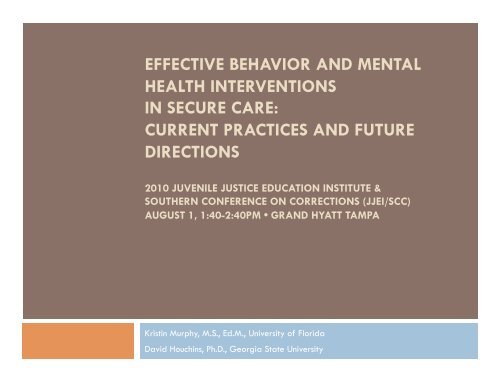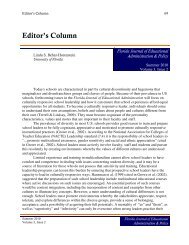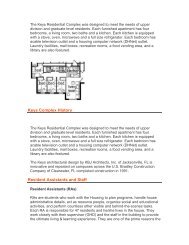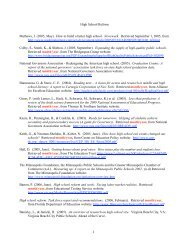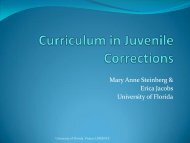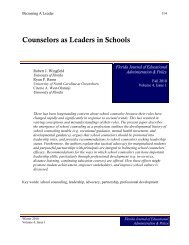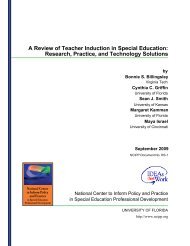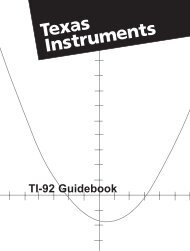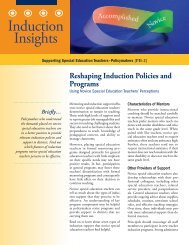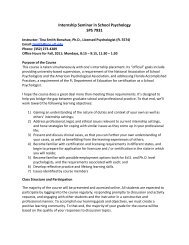Provision of Appropriate Behavior and Mental Health Services
Provision of Appropriate Behavior and Mental Health Services
Provision of Appropriate Behavior and Mental Health Services
You also want an ePaper? Increase the reach of your titles
YUMPU automatically turns print PDFs into web optimized ePapers that Google loves.
EFFECTIVE BEHAVIOR AND MENTAL<br />
HEALTH INTERVENTIONS<br />
IN SECURE CARE:<br />
CURRENT PRACTICES AND FUTURE<br />
DIRECTIONS<br />
2010 JUVENILE JUSTICE EDUCATION INSTITUTE &<br />
SOUTHERN CONFERENCE ON CORRECTIONS (JJEI/SCC)<br />
AUGUST 1, 1:40-2:40PM • GRAND HYATT TAMPA<br />
Kristin Murphy, M.S., Ed.M., University <strong>of</strong> Florida<br />
David Houchins, Ph.D., Georgia State University
Agenda<br />
! Guiding Questions<br />
! Student Characteristics in Secure Care<br />
! Major Issues: Policy vs. Practical Realities<br />
! Intake <strong>and</strong> Assessment<br />
! <strong>Provision</strong> <strong>of</strong> <strong>Appropriate</strong> <strong>Behavior</strong> <strong>and</strong> <strong>Mental</strong> <strong>Health</strong><br />
Practices<br />
! Strategies for Treatment<br />
! Uses <strong>of</strong> Disciplinary Sanctions<br />
! Recommendations for <strong>Provision</strong> <strong>of</strong> <strong>Appropriate</strong> <strong>Behavior</strong>/<br />
<strong>Mental</strong> <strong>Health</strong> Practices
Purpose<br />
! To investigate the alignment <strong>of</strong> mental health <strong>and</strong><br />
behavior policy with practice at the facility level.
Data Collection:<br />
Multiple Sources <strong>of</strong> Evidence<br />
Documents<br />
Direct<br />
Observation<br />
Note. Adapted from Yin (1994)<br />
Personal File<br />
Review<br />
Student <strong>Behavior</strong><br />
<strong>and</strong> <strong>Mental</strong> <strong>Health</strong> Treatment<br />
Within Secure Care:<br />
Current Practices<br />
Focused<br />
Interviews<br />
Surveys
Document Review<br />
! Student Documents<br />
! Student H<strong>and</strong>book<br />
! Student <strong>Behavior</strong> Motivation Program H<strong>and</strong>book,<br />
Related documents (violation form, “Do Right” form)<br />
! Student Guidance <strong>Services</strong> Request form<br />
! Faculty Documents<br />
! Faculty H<strong>and</strong>book<br />
! Staff Job Descriptions<br />
! Facility <strong>Behavior</strong> Management Plan
Personal File Review<br />
! Faculty Credentials<br />
! Functional <strong>Behavior</strong>al Assessments, behavior<br />
intervention plans <strong>and</strong> associated data that<br />
indicates implementation for 15 students<br />
! Current list <strong>of</strong> all students who are on<br />
psychiatric/psychotropic medication currently<br />
<strong>and</strong> the medication(s) they are on<br />
! In-school suspension records, including <strong>of</strong>fense,<br />
name <strong>of</strong> youth, <strong>and</strong> dates in <strong>and</strong> out <strong>of</strong> ISS for<br />
10 students
Personal File Review cont.<br />
June 1-30 snapshot <strong>of</strong>:<br />
! All segregations (including administrative<br />
segregations), indicating whether the infraction<br />
was in school or the living unit, <strong>and</strong> the length <strong>of</strong><br />
time in segregation<br />
! All major/minor <strong>of</strong>fenses received by students<br />
while at school <strong>and</strong> sanctions received for the<br />
<strong>of</strong>fense<br />
! List <strong>of</strong> manifestation determination hearings,<br />
subsequent actions taken, <strong>and</strong> data that was used<br />
to assess progress<br />
! Documentation for student grievances filed !
Case Study<br />
! Case study design was selected:<br />
! to explore the impact <strong>of</strong> the juvenile<br />
correctional setting on the provision <strong>of</strong> mental<br />
health <strong>and</strong> behavior treatment<br />
! To inform facility-level practice <strong>and</strong> policy-level<br />
decisions regarding mental health <strong>and</strong> behavior
Guiding Questions<br />
! To what extent do mental health <strong>and</strong> behavior<br />
policies <strong>and</strong> procedures in secure care align with<br />
NCLB, IDEIA, <strong>and</strong> Florida Statutes?<br />
! What barriers impact implementation <strong>of</strong> mental<br />
health <strong>and</strong> behavior policies in secure care?<br />
! To what extent are mental health <strong>and</strong> behavior<br />
policies <strong>and</strong> procedures implemented in secure<br />
care?<br />
! What facilitates appropriate implementation <strong>of</strong><br />
mental health <strong>and</strong> behavior policies in secure care?
Student Characteristics in Secure Care<br />
! Students in secure care have unique mental<br />
health <strong>and</strong> behavioral needs:<br />
! The rate <strong>of</strong> E/BD in secure care is approximately<br />
six times that <strong>of</strong> regular public schools<br />
(U.S. Department <strong>of</strong> Education, 2009)<br />
! Prevalence <strong>of</strong> students with multiple behavior<br />
<strong>and</strong> mental disorders in secure care:<br />
! It was recently reported that 60% <strong>of</strong> youth with<br />
mental disorders in secure care met the criteria<br />
for 3 or more disorders (Shufelt & Cocozza, 2006).
Student Characteristics in Secure Care<br />
! Abuse <strong>and</strong> neglect <strong>of</strong> students with E/BD<br />
! An estimated 38% were physically or sexually abused<br />
! 41% were neglected<br />
! Over 50% were victims <strong>of</strong> emotional abuse (Oser<strong>of</strong>f,<br />
Oser<strong>of</strong>f, Westling, & Gessner, 1999)<br />
! Over 90% have witnessed or been victims <strong>of</strong> violence<br />
( Abram et al., 2004; Teplin et al., 2002)<br />
! Substance Abuse<br />
! Approximately 45% <strong>of</strong> students in secure care<br />
have substance abuse problems<br />
(Loeber, Burke, & Lahey, 2002; McClell<strong>and</strong>, Elkington, Teplin, & Abram, 2004)
Student Characteristics in Secure Care<br />
! Suicide<br />
" Rates <strong>of</strong> suicidal ideation in incarcerated<br />
youths have been found to be approximately<br />
10%, with lifetime rates <strong>of</strong> 34% reported<br />
(Vermeiren, Jespers, & M<strong>of</strong>fitt, 2006)<br />
" Of facilities who detained youth awaiting<br />
mental health services, 48% reported that<br />
there were suicide attempts among those<br />
youth<br />
(United States House <strong>of</strong> Representatives Committee on Government<br />
Reform-Minority Staff Special Investigation Division, 2004)
Data Collection<br />
! In a r<strong>and</strong>omized sample <strong>of</strong> 15 IEPs:<br />
! Primary Disability:<br />
" 7 EBD, 7 Specific LD, 1 Intellectual Disability<br />
! 13 out <strong>of</strong> 15 are described as demonstrating behavior<br />
that impedes the learning <strong>of</strong> others<br />
" Of those 13 students, 5 have a FBA or BIP (4 <strong>of</strong> those<br />
students are described as SLD, 1 as EBD)<br />
! 9 st<strong>and</strong>ard diploma, 6 special diploma<br />
! 1 enrolled in a self-contained class, 14 enrolled in<br />
general education classes with support
Data Collection<br />
Approximately 57 students<br />
out <strong>of</strong> ~140 are on psychotropic<br />
medication, with a range <strong>of</strong><br />
1-4 medications per student.<br />
The most common reasons for<br />
medication include depression (22),<br />
mood stabilization (20), anxiety<br />
(19), <strong>and</strong> ADHD (18).
Intake <strong>and</strong> Assessment: Policy<br />
! IDEIA: Requires accurate assessment <strong>and</strong><br />
identification <strong>of</strong> students requiring mental health <strong>and</strong><br />
behavior services upon admission<br />
Failure to identify students <strong>and</strong> provide services<br />
for eligible youth can have a serious impact on<br />
the student, <strong>and</strong> put the facility out <strong>of</strong><br />
compliance with federal <strong>and</strong> state law.<br />
(Leone, Krezmien, Mason, & Meisel, 2005).
Intake <strong>and</strong> Assessment: Practical<br />
Realities<br />
! Accurate identification <strong>of</strong> students in correctional<br />
settings is difficult<br />
! <strong>of</strong>ten times prior to admittance they had not<br />
attending school for a long time.<br />
! It is difficult to access records from a child’s home<br />
school<br />
! Many students may have never been diagnosed,<br />
but actually meet guidelines for service
Data Collection<br />
! Intake <strong>and</strong> Assessment:<br />
“The assessment process begins the<br />
moment you arrive”<br />
–Student H<strong>and</strong>book<br />
! At intake, all students are assigned to a therapist <strong>and</strong> a case<br />
manager.!
Data Collection<br />
! Intake <strong>and</strong> Assessment<br />
! Psychosocial – within 24 hours students meet with a<br />
therapist to complete a psychosocial assessment, they also<br />
meet with a licensed mental health pr<strong>of</strong>essional<br />
! DJJ Comprehensive <strong>Mental</strong> <strong>Health</strong>/Substance Abuse<br />
Evaluation: A face-to-face interview with therapist will be<br />
held after students have been in the program for 10 days,<br />
they begin meeting with therapist immediately
Data Collection<br />
! Needs Assessment – within 2 weeks in program, you<br />
meet with your treatment team to develop treatment<br />
plans. Parent/legal guardian, JPO, a rep from the<br />
school, Medical rep, therapist, <strong>and</strong> case manager<br />
! After needs assessment meeting, students receive<br />
individual performance plan, mental health/<br />
substance abuse treatment plan, <strong>and</strong> IEP.
<strong>Provision</strong> <strong>of</strong> <strong>Appropriate</strong> <strong>Behavior</strong> <strong>and</strong><br />
<strong>Mental</strong> <strong>Health</strong> <strong>Services</strong>: Policy<br />
IDEIA (2006, 34 C.F.R. 71. Sec 300.34(c)(10)<br />
! Administering <strong>and</strong> interpreting psychological <strong>and</strong> educational<br />
tests, <strong>and</strong> other assessment procedures;<br />
! Integrating this information into plans for student learning<br />
! Consulting with different school personnel in planning<br />
! Managing a program <strong>of</strong> psychological services, including<br />
psychological counseling for children <strong>and</strong> parents; <strong>and</strong><br />
! Assisting in developing positive behavioral intervention<br />
strategies.
<strong>Provision</strong> <strong>of</strong> <strong>Appropriate</strong> <strong>Behavior</strong> <strong>and</strong><br />
<strong>Mental</strong> <strong>Health</strong> <strong>Services</strong>: Practical Realities<br />
! DOJ has recognized a lack <strong>of</strong> mental health <strong>and</strong><br />
other services for incarcerated youth.<br />
" Findings revealed numerous violations in the area <strong>of</strong> mental<br />
health services in JC facilities.<br />
" In many cases, unqualified staff are providing mental health<br />
services.<br />
" In some cases, no mental staff exists at all (Krezmien, et al., 2008)
Data Collection<br />
! <strong>Provision</strong> <strong>of</strong> <strong>Appropriate</strong> <strong>Mental</strong> <strong>Health</strong> &<br />
<strong>Behavior</strong> Practices<br />
! Within 14 days <strong>of</strong> admittance, students receive a needs<br />
assessment.<br />
! All students have daily life/social skills groups – they may<br />
also have to attend treatment groups on items such as<br />
substance abuse, relapse prevention, thinking errors.<br />
! Students may have the option <strong>of</strong> coordinating a family<br />
session with their therapist
Strategies for Treatment: Policy<br />
" The IEP team must (i)in the case <strong>of</strong> a child whose<br />
behavior impedes the child's learning or that <strong>of</strong> others,<br />
consider the use <strong>of</strong> positive behavioral interventions <strong>and</strong><br />
supports, <strong>and</strong> other strategies to address that behavior<br />
(IDEIA (2006, 34 C.F.R. 71. Sec. 300.324(a)(2)(i)<br />
! Juvenile corrections service providers are charged with<br />
accurately identifying youth with special education or<br />
mental health needs, <strong>and</strong> must provide required<br />
services without delay to children with identified needs<br />
under the IDEIA<br />
(Krezmien, Mulcahy, & Leone, 2008, p. 446)
Strategies for Treatment: Practical Realities<br />
! The juvenile justice system is overwhelmed with providing<br />
adequate mental health services for the large number <strong>of</strong><br />
students needing treatment (Teplin, Abram, McClell<strong>and</strong>,<br />
Dulcan, & Mericle, 2002)
Data Collection<br />
! Strategies for Treatment:<br />
! Treatment Team:<br />
" Consists <strong>of</strong> student, case manager, therapist, teachers,<br />
administrative staff, youth care workers in their dorm.<br />
" The team meets in full once a month.<br />
" A positive review is given for demonstrating progress on<br />
goals <strong>and</strong> a negative review is given for not meeting<br />
progress. Positive reviews are associated with level<br />
promotion, <strong>and</strong> obtaining a recommendation for release<br />
from the program.
Data Collection<br />
! Strategies for Treatment<br />
! Case Management:<br />
" Case Manager keeps the student in touch with family <strong>and</strong><br />
provides Progress Reports to Judge, DJJ probation <strong>of</strong>ficer,<br />
<strong>and</strong> to parents/guardians.<br />
" Coordinates any required community service<br />
" Meets regularly with students to monitor progress in<br />
between Treatment Team meetings<br />
Peer Counselors: Students have the opportunity to<br />
become peer counselors. One <strong>of</strong> the benefits <strong>of</strong><br />
this is that this position will be mentioned in monthly<br />
summaries to a student’s Judge.
Uses <strong>of</strong> Disciplinary Sanctions: Policy<br />
! NCLB <strong>and</strong> FL State Statutes may conflict with IDEIA<br />
when it comes to behavior management <strong>of</strong> students:<br />
" A student’s disability must be taken into account when<br />
determining discipline – behavioral difficulties should<br />
be addressed through positive behavior interventions<br />
<strong>and</strong> supports (IDEIA 34 C.F.R. Sec. 300.324 (a)(2)(i)<br />
" NCLB has emphasized the importance <strong>of</strong> school<br />
safety as a means <strong>of</strong> promoting student success. All<br />
schools must provide records <strong>of</strong> school safety plans.<br />
" However, NCLB <strong>and</strong> FL State Statutes allow for<br />
teachers to have disruptive students removed from<br />
the classroom for behavior management intervention.
Uses <strong>of</strong> Disciplinary Sanctions: Practical<br />
Realities<br />
! Utilizing approaches that are punitive in nature or<br />
segregation are commonplace <strong>and</strong> <strong>of</strong>ten used in place<br />
<strong>of</strong> evidence based mental health practices.<br />
! Students with disabilities in secure care frequently do<br />
not receive appropriate academic <strong>and</strong> behavioral<br />
accommodations <strong>and</strong> typically spend more time in<br />
disciplinary confinement (Leone, 1994).<br />
! Disciplinary practices in school tend to remove students<br />
from instruction, having a negative impact on academics
Data Collection<br />
Use <strong>of</strong> Disciplinary Sanctions<br />
! This facility works on a level system – allowing more privileges as<br />
a student progresses through levels based on Prosocial behavior.<br />
! Students “move” across levels based on # <strong>of</strong> days violation free<br />
or major violation free, <strong>and</strong> positive performance reviews during<br />
treatment team<br />
" Level suspension occurs if a student does not maintain requirements <strong>of</strong><br />
a certain level.<br />
! Privileges range from additional phone calls <strong>and</strong> participation in<br />
student council, to getting to wear a special uniform <strong>and</strong><br />
permission to attend <strong>of</strong>f-campus activities.<br />
! “Do Right” – Students can receive “Do Right” forms during the<br />
day, for demonstrating prosocial behaviors. The form indicates<br />
what they did. Top ten students in each dorm with the most “Do<br />
Rights” get to participate in a weekly “Top Ten Night.”
Data Collection<br />
! “Anti-social or negative behavior” results in Minor,<br />
Serious, or Major Violations.<br />
" Staff member writes up violation, student can sign <strong>and</strong><br />
comment on violation.<br />
! Disciplinary Review Board Hearings<br />
" Held twice weekly to quickly address serious behavior or<br />
treatment concerns. If necessary, addendums to the IEP or<br />
IPP may result from these meetings.<br />
" Addendums are additional goals that students must complete<br />
before they are released.
Recommendations<br />
! Use <strong>of</strong> a comprehensive screening protocol for all<br />
students upon admittance to the facility<br />
(Krezmien, Mulcahy, & Leone, 2008):<br />
! Academic<br />
! <strong>Mental</strong> health<br />
! Medical History, Medication Use<br />
This would result in accurate identification <strong>of</strong> student<br />
needs, improve <strong>and</strong> accelerate the provision <strong>of</strong><br />
educational <strong>and</strong> mental health services <strong>and</strong> ensure<br />
alignment with IDEIA requirements.
Recommendations<br />
! Implementation <strong>of</strong> Schoolwide Positive <strong>Behavior</strong><br />
Interventions <strong>and</strong> Supports (SWPBIS)<br />
(Gagnon, Rockwell, & Scott, 2008)<br />
! Cognitive <strong>Behavior</strong>al Therapy (CBT)<br />
! Therapeutic Orientation <strong>of</strong> Treatment<br />
(Greenwood & Turner, 2009)<br />
! These should be combined with other practices such as<br />
group <strong>and</strong> individual counseling (Guerra, Kim, & Boxer, 2008).
Recommendations: Systems <strong>of</strong> Care<br />
Approach<br />
Collaboration across educational, correctional, <strong>and</strong><br />
mental health staff, in addition to personnel<br />
preparation programs, researchers <strong>and</strong> policy<br />
makers, is necessary for success!
Questions or Comments?<br />
Kristin Murphy: kristin.murphy@ufl.edu<br />
Dr. David Houchins: epedeh@langate.gsu.edu<br />
For additional information, <strong>and</strong> to download a copy<br />
<strong>of</strong> this presentation, please visit:<br />
http://coe.ufl.edu/Projects/liberate
References<br />
Baxter, P. & Jack, S. (2008). Qualitative case study methodology: Study design <strong>and</strong> implementation for novice researchers. The<br />
Qualitative Report, 13, 544-559.<br />
Connor, D.F. (2002). Aggression <strong>and</strong> antisocial behavior in children <strong>and</strong> adolescence: Research <strong>and</strong> treatment. New York: Guilford<br />
Press.<br />
Gagnon, J. C., Rockwell, S., & Scott, T. M. (2008). Positive behavior supports in exclusionary<br />
schools: A practical approach based on what we know. Focus on Exceptional Children, 41(1), 1-20.<br />
Greenwood, P. & Turner, S. (2009). An overview <strong>of</strong> prevention <strong>and</strong> intervention programs for juvenile <strong>of</strong>fenders. Victims &<br />
Offenders, 4(4), 365-374.<br />
Hancock, D.R. & Algozzine, B. (2006). Doing Case Study Research: A Practical Guide for Beginning Researchers. New York, NY: Sage.<br />
Krezmien, M. P., Mulcahy, C. A., & Leone, P. E. (2008). Detained <strong>and</strong> committed youth: Examining differences in achievement, mental<br />
health needs, <strong>and</strong> special education status. Education <strong>and</strong> Treatment <strong>of</strong> Children, 31, 445-464.<br />
Leone, P. E. & Cutting, C. A. (2004). <strong>Appropriate</strong> education, juvenile corrections, <strong>and</strong> No Child Left Behind. <strong>Behavior</strong> Disorders, 29,<br />
260-265.<br />
Loeber, R., Burke, J., & Lahey, B. (2002). What are the antecedents to an antisocial personality disorder? Criminal <strong>Behavior</strong> <strong>and</strong><br />
<strong>Mental</strong> <strong>Health</strong>, 12, 24-36.<br />
McClell<strong>and</strong>, G., M., Elkington, K., S., Teplin, L., A., & Abram, K. M. (2004). Multiple substance use disorders in juvenile detainees.<br />
Journal <strong>of</strong> the American Academy <strong>of</strong> Child & Adolescent Psychiatry, 43(10), 1215-1224.<br />
Merton, R.K., Fiske, M., & Kendall, P.L. (1990). The Focused Interview: A Manual <strong>of</strong> Problems <strong>and</strong> Procedures. (2 nd ed.). New York, NY:<br />
Free Press.<br />
Patton, M.Q. (1987). How to Use Qualitative Methods in Evaluation. Newbury Park, CA: Sage Publications.<br />
Pullman, M. D., Kerbs, J., Korol<strong>of</strong>f, N., Veach-White, E., Gaylor, E., & Sieler, D. (2006). Juvenile <strong>of</strong>fenders with mental health needs:<br />
Reducing recidivism using wraparound. Crime & Delinquency, 52, 375-397.
References continued<br />
Shufelt, J., & Cocozza, J. (2006). Youth with mental health disorders in the juvenile justice system: Results from a<br />
multi-state prevalence study. Retrieved July 15, 2010 from<br />
http://www.ncmhjj.com/pdfs/publications/PrevalenceRPB.pdf<br />
Teplin, L.A., Abram, K.M., McClell<strong>and</strong>, G.M., Dulcan, M.K., Mericle, A.A. (2002). Psychiatric disorders in youth in<br />
juvenile detention. Archives <strong>of</strong> General Psychiatry, 59, 1133-1143.<br />
Teplin, L. A., Abram, K. M., McClell<strong>and</strong>, G. M., Washburn, J. J., & Pikus, A. K. (2005). Detecting mental disorder in<br />
juvenile detainees: Who receives services. American Journal <strong>of</strong> Public <strong>Health</strong>, 95, 1773-1780.<br />
U.S. Department <strong>of</strong> Education. (2009). 28 th annual report to congress on the implementation <strong>of</strong> the Individuals with<br />
Disabilities Education Act. Washington, DC: Author.<br />
U.S. House <strong>of</strong> Representatives Committee on Government Reform – Minority Staff Special Investigation Division<br />
(2004). Incarceration <strong>of</strong> youth who are waiting for community mental health services in the United States.<br />
Washington, DC: United States House <strong>of</strong> Representatives Committee on Government Reform – Minority Staff<br />
Special Investigation Division.<br />
Vermeiren, R., Jespers, I., & M<strong>of</strong>fitt, T. (2006). <strong>Mental</strong> health problems in juvenile justice populations. Child <strong>and</strong> Adolescent<br />
Psychiatric Clinics <strong>of</strong> North America, 15, 333-351.<br />
Yin, R.K. (1994). Case study research: Designs <strong>and</strong> methods. (2nd ed.). Thous<strong>and</strong> Oaks, CA: Sage Publications.


